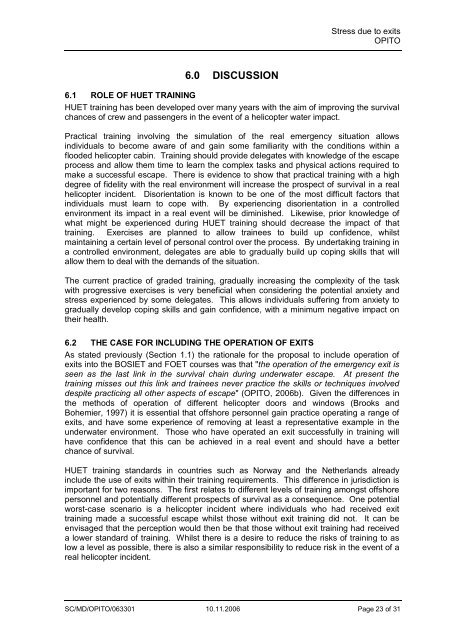Stress levels associated with huet - Opito
Stress levels associated with huet - Opito
Stress levels associated with huet - Opito
Create successful ePaper yourself
Turn your PDF publications into a flip-book with our unique Google optimized e-Paper software.
6.0 DISCUSSION<br />
<strong>Stress</strong> due to exits<br />
OPITO<br />
6.1 ROLE OF HUET TRAINING<br />
HUET training has been developed over many years <strong>with</strong> the aim of improving the survival<br />
chances of crew and passengers in the event of a helicopter water impact.<br />
Practical training involving the simulation of the real emergency situation allows<br />
individuals to become aware of and gain some familiarity <strong>with</strong> the conditions <strong>with</strong>in a<br />
flooded helicopter cabin. Training should provide delegates <strong>with</strong> knowledge of the escape<br />
process and allow them time to learn the complex tasks and physical actions required to<br />
make a successful escape. There is evidence to show that practical training <strong>with</strong> a high<br />
degree of fidelity <strong>with</strong> the real environment will increase the prospect of survival in a real<br />
helicopter incident. Disorientation is known to be one of the most difficult factors that<br />
individuals must learn to cope <strong>with</strong>. By experiencing disorientation in a controlled<br />
environment its impact in a real event will be diminished. Likewise, prior knowledge of<br />
what might be experienced during HUET training should decrease the impact of that<br />
training. Exercises are planned to allow trainees to build up confidence, whilst<br />
maintaining a certain level of personal control over the process. By undertaking training in<br />
a controlled environment, delegates are able to gradually build up coping skills that will<br />
allow them to deal <strong>with</strong> the demands of the situation.<br />
The current practice of graded training, gradually increasing the complexity of the task<br />
<strong>with</strong> progressive exercises is very beneficial when considering the potential anxiety and<br />
stress experienced by some delegates. This allows individuals suffering from anxiety to<br />
gradually develop coping skills and gain confidence, <strong>with</strong> a minimum negative impact on<br />
their health.<br />
6.2 THE CASE FOR INCLUDING THE OPERATION OF EXITS<br />
As stated previously (Section 1.1) the rationale for the proposal to include operation of<br />
exits into the BOSIET and FOET courses was that "the operation of the emergency exit is<br />
seen as the last link in the survival chain during underwater escape. At present the<br />
training misses out this link and trainees never practice the skills or techniques involved<br />
despite practicing all other aspects of escape" (OPITO, 2006b). Given the differences in<br />
the methods of operation of different helicopter doors and windows (Brooks and<br />
Bohemier, 1997) it is essential that offshore personnel gain practice operating a range of<br />
exits, and have some experience of removing at least a representative example in the<br />
underwater environment. Those who have operated an exit successfully in training will<br />
have confidence that this can be achieved in a real event and should have a better<br />
chance of survival.<br />
HUET training standards in countries such as Norway and the Netherlands already<br />
include the use of exits <strong>with</strong>in their training requirements. This difference in jurisdiction is<br />
important for two reasons. The first relates to different <strong>levels</strong> of training amongst offshore<br />
personnel and potentially different prospects of survival as a consequence. One potential<br />
worst-case scenario is a helicopter incident where individuals who had received exit<br />
training made a successful escape whilst those <strong>with</strong>out exit training did not. It can be<br />
envisaged that the perception would then be that those <strong>with</strong>out exit training had received<br />
a lower standard of training. Whilst there is a desire to reduce the risks of training to as<br />
low a level as possible, there is also a similar responsibility to reduce risk in the event of a<br />
real helicopter incident.<br />
SC/MD/OPITO/063301 10.11.2006 Page 23 of 31




